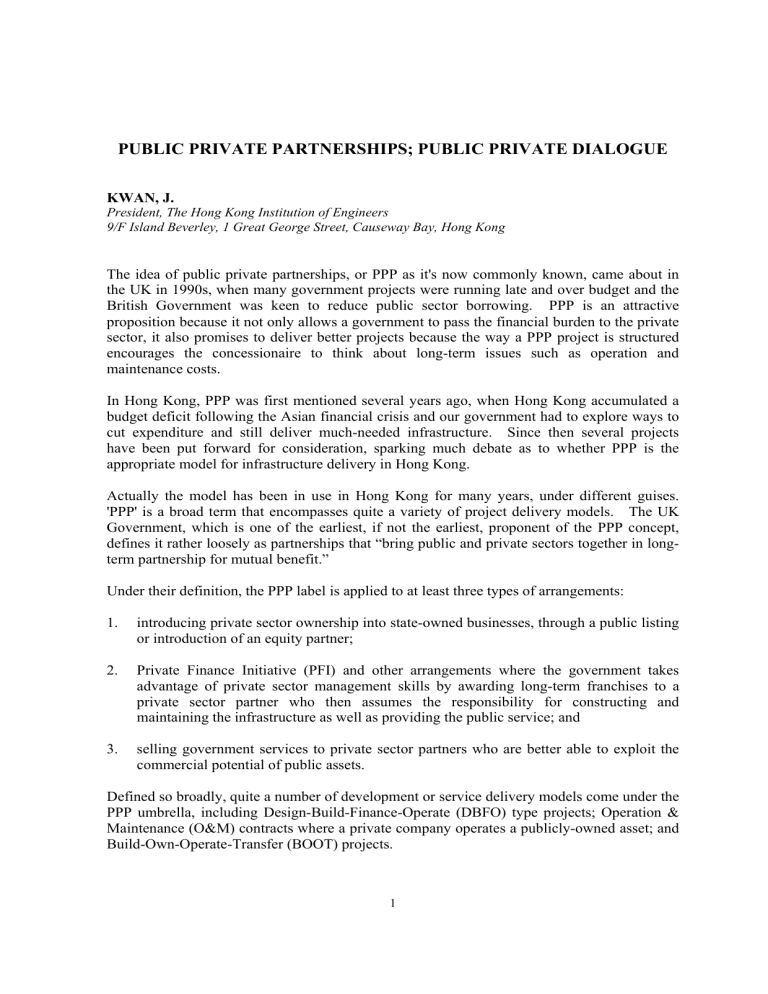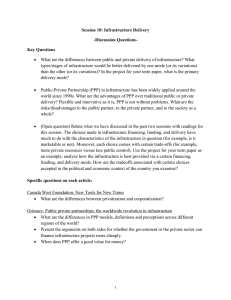
PUBLIC PRIVATE PARTNERSHIPS; PUBLIC PRIVATE DIALOGUE KWAN, J. President, The Hong Kong Institution of Engineers 9/F Island Beverley, 1 Great George Street, Causeway Bay, Hong Kong The idea of public private partnerships, or PPP as it's now commonly known, came about in the UK in 1990s, when many government projects were running late and over budget and the British Government was keen to reduce public sector borrowing. PPP is an attractive proposition because it not only allows a government to pass the financial burden to the private sector, it also promises to deliver better projects because the way a PPP project is structured encourages the concessionaire to think about long-term issues such as operation and maintenance costs. In Hong Kong, PPP was first mentioned several years ago, when Hong Kong accumulated a budget deficit following the Asian financial crisis and our government had to explore ways to cut expenditure and still deliver much-needed infrastructure. Since then several projects have been put forward for consideration, sparking much debate as to whether PPP is the appropriate model for infrastructure delivery in Hong Kong. Actually the model has been in use in Hong Kong for many years, under different guises. 'PPP' is a broad term that encompasses quite a variety of project delivery models. The UK Government, which is one of the earliest, if not the earliest, proponent of the PPP concept, defines it rather loosely as partnerships that “bring public and private sectors together in longterm partnership for mutual benefit.” Under their definition, the PPP label is applied to at least three types of arrangements: 1. introducing private sector ownership into state-owned businesses, through a public listing or introduction of an equity partner; 2. Private Finance Initiative (PFI) and other arrangements where the government takes advantage of private sector management skills by awarding long-term franchises to a private sector partner who then assumes the responsibility for constructing and maintaining the infrastructure as well as providing the public service; and 3. selling government services to private sector partners who are better able to exploit the commercial potential of public assets. Defined so broadly, quite a number of development or service delivery models come under the PPP umbrella, including Design-Build-Finance-Operate (DBFO) type projects; Operation & Maintenance (O&M) contracts where a private company operates a publicly-owned asset; and Build-Own-Operate-Transfer (BOOT) projects. 1 From this, we can see that PPP in fact has quite a long history in Hong Kong. The Cross Harbour Tunnel, which has now been transferred back to the public sector, would be an example. Others include our strategic landfills and the Chemical Waste Treatment Plant on Tsing Yi Island; the Tsing Ma Control Area; and the new exhibition and conference centre at Hong Kong International Airport. These projects represent a good spectrum of the PPP model. The strategic landfills and the Chemical Waste Treatment Plant are run by private operators who are paid a fee by the government according to the amount of waste handled. The Tsing Ma Control Area consists of 16 kilometres of highways run by a private consortium which collects tolls from users to pay for the area's management, operation and maintenance. Finally, AsiaWorld-Expo, the new exhibition and conference centre, is being developed with a combination of public and private equity and will be run by a private management company. These projects demonstrate that PPP works in Hong Kong. However, we also have cases where the model does not work so well. The Western Harbour Crossing is one. Included in the Western Harbour Crossing concession agreement is a toll adjustment mechanism which allows tolls to be automatically adjusted upwards if traffic volume fails to generate the amount of revenue expected. Conversely, it allows a toll increase to be deferred if traffic volume exceeds projections. Unfortunately, this mechanism only works when the economy is good. During the economic downturn of the past few years, the low volume of traffic has led the franchisee to increase toll in a bid to make up for the revenue shortfall, causing more motorists to switch to the other two cross harbour tunnels. The River Trade Terminal in Tuen Mun is another case. Under the terms of the land grant which gave the River Trade Terminal Company Ltd the right to build and operate the terminal, the operator must confine itself to the consolidation of containers and bulk cargo shipped between the port in Hong Kong and ports in the Pearl River Delta. However, this operational model has proved unprofitable and the company has been forced to extend its services to cover containers from other Asian ports. As a result, the government has taken the company to court. All these cases, the successful ones as well as the not so successful ones, demonstrate that, apart from examining the justifications for going the PPP route – that is, justifications from the government's point of view - a government must also look at how the model serves the interests of the other stakeholders. What are the justifications for going the PPP route? Governments usually go the PPP route because of a need to cut government spending or deliver infrastructure without additional government expenditure. Usually there is also a wish to transfer the risk associated with the operation of the public facilities or services under consideration. In more enlightened cases, there is a real recognition that the private sector possesses management expertise and innovative ideas that will help operate the facilities or services better than the public sector. From these justifications, we can see that the interests of the stakeholders are not always accorded equal importance. 2 Who are the stakeholders? 1. 2. 3. 4. They fall into four categories: The government and, by extension, the taxpayers The private sector partner The consumers or end-users of the facility or service The employees of the PPP entity If the primary motive is to offload a financial burden and transfer the associated risk to another party, with inadequate regard for the return on investment the private sector partner stands to make, then one or more stakeholders are bound to suffer as a result. Take for example a PPP experiment which calls for the private sector to offer a fixed price period contract for highways maintenance, without the current state of the assets involved being known. Now while the private sector can price the service delivery, it really is the responsibility of the public sector to quantify and assume the risk posed by the assets in question, such as the street lights, the barriers, and so on. Otherwise the risk sharing is simply not fair. Now the government has proposed two PPP schemes involving the development and operation rights for an ice skating rink in Tseung Kwan O and a bowling centre and swimming pool complex in Kwun Tong. The arrangements involve developers being awarded a plot of land with the requirement that they build and operate the leisure facilities as an adjunct to their property developments. The problem here is that, to make the construction and operation of the public leisure facilities attractive, the government has tagged them onto a typical land deal. Successful PPP cases overseas tend to offer their operators a stable income stream. Now given that such leisure facilities do not provide such an income stream, what incentive is there to guarantee that the private developer will be committed to operating them to the required standard over the long term? If the argument is that these facilities will enhance the value of the property development, then why would developers require the additional government incentive to build such facilities? After all, they already provide ice skating rinks, cinemas and other public facilities within their developments, without cost to the taxpayer. On a much larger scale, we may ask the same questions of the proposal to develop the West Kowloon Cultural District as a PPP. In this case, the developer is being asked to manage vast cultural facilities such as museums and opera houses. Given that there is no guarantee these cultural facilities will create a stable income stream for the developer, what incentive is there for the developer to manage these facilities to a high standard over the long term? Suppose clauses are inserted in the development agreement to make sure the developer does manage the facilities over the long term, is it fair for the developer to assume the risk of poor returns? As I mentioned before, the opportunity to tap private sector expertise is one reason for choosing PPP. Property developers who have no experience in operating such cultural facilities will bring in specialists to do the job for them; then will the management and operation contracts for these facilities be just between the developer and the operators, and who will be in a position to apply incentives and penalties to ensure the specialist operators deliver? We must also consider the position of the end-users. How will a PPP provide better facility 3 or service, at a better value, to the end-user? Users may be willing to pay more for a more efficiently-run facility or service, but this also depends on the extent to which this facility or service remains affordable to them. On the other hand, if the private sector operator is forced to keep fees low, it may not be able to maintain the quality of the facility or service at an optimum level. It is quite a challenge to get the balance right. In terms of employment, greenfield projects have an obvious advantage because they create employment, whereas the transfer of any existing facility or service into the hands of a private operator may have a negative impact on the livelihood of the existing employees. That is why our government's plan to adopt the PPP model for the reprovisioning of the Shatin Water Treatment Plant has given rise to so much concern. Getting a PPP to work requires quite a delicate balancing act. As investors we want the government to offer us sufficient incentive for assuming the risk of developing and operating a public asset, but as users we don't want these incentives to mean we have to pay more for the service. What we really need in Hong Kong now is better dialogue. We have highly experienced private sector operators who can identify the facilities or services which could be developed and operated as PPPs and who can tell us, based on their experience, how these projects will perform. Then we can have a better picture of the capital, operation and maintenance costs right from the beginning. The Tate's Cairn Tunnel, another BOT project in Hong Kong, was the brainchild of the private sector and is now operating smoothly. The government must adopt the same open attitude towards similar proposals. Rather than choosing PPP experiments behind closed doors, all the stakeholders would be much better served if they can sit down together to discuss all the pertinent issues of costs, benefits and risk allocation. Right now we are in a situation where our infrastructure needs to be improved but the government is hamstrung by its concern for the current account deficit. There are many projects which can be undertaken as PPPs and our construction industry, which has been suffering from a lack of activity for some time, would welcome the opportunity to become partners in these schemes. But we must be careful. We want PPPs that will benefit all the stakeholders and Hong Kong as a whole. For them to be successful, we must engage in a dialogue. 4
